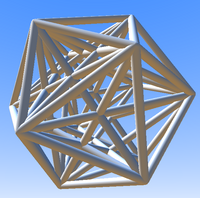6-orthoplex Rank 6 Type Regular Notation Bowers style acronym G eeCoxeter diagram x3o3o3o3o4o ( Schläfli symbol {3,3,3,3,4} Bracket notation <IIIIII> Elements Peta 64 5-simplices Tera 192 pentachora Cells 240 tetrahedra Faces 160 triangles Edges 60 Vertices 12 Vertex figure 5-orthoplex , edge length 1Petrie polygons 1920
{
12
1
,
3
,
5
}
{\displaystyle \left\{{\frac {12}{1,3,5}}\right\}}
Measures (edge length 1) Circumradius
2
2
≈
0.70711
{\displaystyle {\frac {\sqrt {2}}{2}}\approx 0.70711}
Edge radius
1
2
=
0.5
{\displaystyle {\frac {1}{2}}=0.5}
Face radius
6
6
≈
0.40825
{\displaystyle {\frac {\sqrt {6}}{6}}\approx 0.40825}
Cell radius
2
4
≈
0.35355
{\displaystyle {\frac {\sqrt {2}}{4}}\approx 0.35355}
Teron radius
10
10
≈
0.31623
{\displaystyle {\frac {\sqrt {10}}{10}}\approx 0.31623}
Inradius
3
6
≈
0.28868
{\displaystyle {\frac {\sqrt {3}}{6}}\approx 0.28868}
Hypervolume
1
90
≈
0.011111
{\displaystyle {\frac {1}{90}}\approx 0.011111}
Dipetal angle
arccos
(
−
2
3
)
≈
131.81032
∘
{\displaystyle \arccos \left(-{\frac {2}{3}}\right)\approx 131.81032^{\circ }}
Height
3
3
≈
0.57735
{\displaystyle {\frac {\sqrt {3}}{3}}\approx 0.57735}
Central density 1 Number of external pieces 64 Level of complexity 1 Related polytopes Army Gee Regiment Gee Dual 6-cube Conjugate None Abstract & topological properties Flag count46080 Euler characteristic 0 Orientable Yes Properties Symmetry B6 , order 46080Flag orbits 1 Convex Yes Net count502110 Nature Tame
The 6-orthoplex (OBSA : g eehexacross or hexacontatetrapeton , is a regular 6-polytope . It has 64 regular 5-simplices as facets, joining 3 to a tetrahedron peak and 32 to a vertex in a triacontaditeral arrangement. It is the 6-dimensional orthoplex . It is also an octahedral duotegum and square triotegum , triacontaditeric tegum , icosahedron-great icosahedron step prism , and 12-3-5 step prism.
It can also be seen as a segmentopeton as a 5-simplex antiprism .
The vertices of a regular 6-orthoplex of edge length 1, centered at the origin, are given by all permutations of:
(
±
2
2
,
0
,
0
,
0
,
0
,
0
)
{\displaystyle \left(\pm {\frac {\sqrt {2}}{2}},\,0,\,0,\,0,\,0,\,0\right)}
A 6-orthoplex has the following Coxeter diagrams :
x3o3o3o3o4o ( (full symmetry)
x3o3o3o3o *d3o ( (D6 symmetry)
xo3oo3oo3oo3ox&#x (A5 axial, hexateric antiprism)
ooo4ooo3ooo3ooo3oxo&#xt (B5 axial, triacontaditeric bipyramid)
qo oo4oo3oo3oo3ox&#zx (B5 ×A1 symmetry)
oo3ooo3ooo *b3ooo3oxo&#xt (D5 axial, still triacontaditeric bipyramid)
qo oo3oo3oo *c3oo3ox&#zx (D5 ×A1 symmety)
oxoo3oooo3oooo3ooox&#x (A4 axial)
oqo xoo3ooo3ooo3oox&#xt (A4 ×A1 axial, pentachoron-first)
xox ooo4ooo3ooo3oxo&#xt (B4 ×A1 symmetry, edge-first)
xox oxo3ooo3ooo *c3ooo&#xt (D4 ×A1 axial, still edge-first)
xo4oo oo4oo3oo3ox&#zx (B4 ×B2 symmetry, square-hexadecachoron duotegum)
xo xo ox3oo3oo *d3oo&#zx (D4 ×A1 ×A1 symmetry, rectangle-demitesseract duotegum)
oxo4ooo xoo3ooo3oox&#xt (A3 ×B2 symmetry, tetrahedron-first)
oxo oxo xoo3ooo3oox&#xt (A3 ×A1 ×A1 symmetry, still tetrahedron-first)
xoxo oxoo3oooo3ooox&#xr (A3 ×A1 axial)
xoo3oox ooo4ooo3oox&#xt (B3 ×A2 axial, triangle-first)
xoo3oox ooo3oxo3ooo&#xt (A3 ×A2 axial, triangle-first)
oo4oo3xo oo4oo3ox&#zx (B3 ×B3 symmetry, octahedral duotegum)
oo3xo3oo oo3ox3oo&#zx (A3 ×A3 symmetry, tetratetrahedral duotegum)
xooo3ooxo oxoo3ooox&#xr (A2 ×A2 symmetry)
xoo4ooo oxo4ooo oox4ooo&#zx (B2 ×B2 ×B2 symetry, square triotegum)
xoo xoo oxo oxo oox oox&#zx (rectangular triotegum) The regiment of the 6-orthoplex includes a total of 13 known uniform members, including itself, 1 with D6 symmetry (the triacontadihemihexeract ), 4 with hexateric antiprism symmetry, 2 with doubled icosahedral step prism symmetry, 1 with icosahedral step prism symmetry, and 4 with triangular disphenoidal antiprismatic symmetry. The regiment also includes a number of scaliforms.
Name OBSA Schläfli symbol CD diagram 6-cube ax {4,3,3,3,3} Rectified 6-cube rax r{4,3,3,3,3} Birectified 6-cube brox t2 {4,3,3,3,3} Birectified 6-orthoplex brag t2 {3,3,3,3,4} Rectified 6-orthoplex rag r{3,3,3,3,4} 6-orthoplex gee {3,3,3,3,4} Truncated 6-cube tox t{4,3,3,3,3} Cantellated 6-cube srox rr{4,3,3,3,3} Runcinated 6-cube spox t0,3 {4,3,3,3,3} Stericated 6-cube scox t0,4 {4,3,3,3,3} Pentellated 6-cube stoxog t0,5 {4,3,3,3,3} Bitruncated 6-cube botox t1,2 {4,3,3,3,3} Bicantellated 6-cube saborx t1,3 {4,3,3,3,3} Biruncinated 6-cube sobpoxog t1,4 {4,3,3,3,3} Stericated 6-orthoplex scag t0,4 {3,3,3,3,4} Tritruncated 6-cube xog t2,3 {4,3,3,3,3} Bicantellated 6-orthoplex siborg t1,3 {3,3,3,3,4} Runcinated 6-orthoplex spog t0,3 {3,3,3,3,4} Bitruncated 6-orthoplex botag t1,2 {3,3,3,3,4} Cantellated 6-orthoplex srog rr{3,3,3,3,4} Truncated 6-orthoplex tag t{3,3,3,3,4} Cantitruncated 6-cube grox tr{4,3,3,3,3} Runcitruncated 6-cube potax t0,1,3 {4,3,3,3,3} Steritruncated 6-cube catax t0,1,4 {4,3,3,3,3} Pentitruncated 6-cube tacog t0,1,5 {4,3,3,3,3} Runcicantellated 6-cube prox t0,2,3 {4,3,3,3,3} Stericantellated 6-cube crax t0,2,4 {4,3,3,3,3} Penticantellated 6-cube topag t0,2,5 {4,3,3,3,3} Steriruncinated 6-cube copox t0,3,4 {4,3,3,3,3} Penticantellated 6-orthoplex tapox t0,2,5 {3,3,3,3,4} Pentitruncated 6-orthoplex tacox t0,1,5 {3,3,3,3,4} Bicantitruncated 6-cube gaborx t1,2,3 {4,3,3,3,3} Biruncitruncated 6-cube boprag t1,2,4 {4,3,3,3,3} Steriruncinated 6-orthoplex copog t0,3,4 {3,3,3,3,4} Biruncitruncated 6-orthoplex boprax t1,2,4 {3,3,3,3,4} Stericantellated 6-orthoplex crag t0,2,4 {3,3,3,3,4} Steritruncated 6-orthoplex catog t0,1,4 {3,3,3,3,4} Bicantitruncated 6-orthoplex gaborg t1,2,3 {3,3,3,3,4} Runcicantellated 6-orthoplex prog t0,2,3 {3,3,3,3,4} Runcitruncated 6-orthoplex potag t0,1,3 {3,3,3,3,4} Cantitruncated 6-orthoplex grog tr{3,3,3,3,4} Runcicantitruncated 6-cube gippox t0,1,2,3 {4,3,3,3,3} Stericantitruncated 6-cube cagorx t0,1,2,4 {4,3,3,3,3} Penticantitruncated 6-cube togrix t0,1,2,5 {4,3,3,3,3} Steriruncitruncated 6-cube captix t0,1,3,4 {4,3,3,3,3} Pentiruncitruncated 6-cube tocrag t0,1,3,5 {4,3,3,3,3} Pentisteritruncated 6-cube tactaxog t0,1,4,5 {4,3,3,3,3} Steriruncicantellated 6-cube coprix t0,2,3,4 {4,3,3,3,3} Pentiruncicantellated 6-cube tiprixog t0,2,3,5 {4,3,3,3,3} Pentiruncitruncated 6-orthoplex tocrax t0,1,3,5 {3,3,3,3,4} Penticantitruncated 6-orthoplex togrig t0,1,2,5 {3,3,3,3,4} Biruncicantitruncated 6-cube gobpoxog t1,2,3,4 {4,3,3,3,3} Steriruncicantellated 6-orthoplex coprag t0,2,3,4 {3,3,3,3,4} Steriruncitruncated 6-orthoplex captog t0,1,3,4 {3,3,3,3,4} Stericantitruncated 6-orthoplex cagorg t0,1,2,4 {3,3,3,3,4} Runcicantitruncated 6-orthoplex gopog t0,1,2,3 {3,3,3,3,4} Steriruncicantitruncated 6-cube gocax t0,1,2,3,4 {4,3,3,3,3} Pentiruncicantitruncated 6-cube tagpox t0,1,2,3,5 {4,3,3,3,3} Pentistericantitruncated 6-cube tocagrax t0,1,2,4,5 {4,3,3,3,3} Pentistericantitruncated 6-orthoplex tecagorg t0,1,2,4,5 {3,3,3,3,4} Pentiruncicantitruncated 6-orthoplex tagpog t0,1,2,3,5 {3,3,3,3,4} Steriruncicantitruncated 6-orthoplex gocog t0,1,2,3,4 {3,3,3,3,4} Omnitruncated 6-cube gotaxog t0,1,2,3,4,5 {4,3,3,3,3}











 ) (full symmetry)
) (full symmetry)







 ) (D6 symmetry)
) (D6 symmetry)









